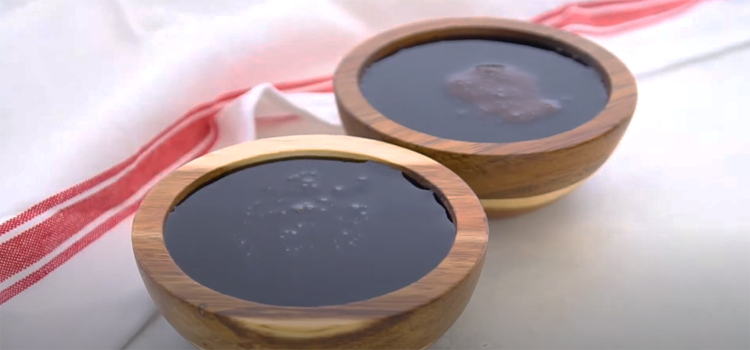Last Updated on July 15, 2024 by Shari Mason
**Balsamic vinegar** and **balsamic glaze** *bring a burst of flavor* to meals, making salad dressings taste **incredible**.
While they are both made from grapes, we’re wondering if they’re interchangeable despite their different production methods and resulting taste profiles.
Today, we will explore the differences between balsamic glaze and balsamic vinegar and discuss whether or not balsamic glaze can be used instead of balsamic vinegar in cooking and dressing.
Can Balsamic Glaze Be Used As A Substitute For Balsamic Vinegar?


Yes. Balsamic glaze [1] can be used as a substitute for balsamic vinegar in some dishes, but it is not suitable for all recipes.
Its thick consistency and sweet taste make it best used as a finishing touch or a drizzle on top of dishes rather than as a full substitute for balsamic vinegar.
For example, it can be used in marinades, dressings, or as a dip. However, it is not as versatile as balsamic vinegar in salad dressings because of its thick consistency and sweetness.
Balsamic vinegar is made from grape must that is aged for at least 12 years, while balsamic glaze is made from reduced balsamic vinegar with added sugar and thickeners.
This gives balsamic vinegar a sharper taste and a more liquid consistency, while balsamic glaze is sweeter and thicker.
It is important to consider the taste and texture of balsamic glaze before using it as a substitute for balsamic vinegar in a recipe and to adjust other ingredients accordingly.
Read:
- Is Sherry Vinegar The Same As Sherry Wine?
- What Kind Of Oil And Vinegar Does Subway Use?
- How To Cut Vinegar Taste In Hot Sauce?
Difference Between Balsamic Glaze & Balsamic Vinegar
Balsamic vinegar [2] ferments pressed grapes, typically Trebbiano or Lambrusco varieties. The juice is aged for a minimum of 12 years in a series of barrels made from different types of wood, such as chestnut, oak, mulberry, and ash.
During this aging process, the vinegar loses some water content and develops a complex flavor profile that includes fruit, wood, and spices notes.
“Red wine vinegar has some personality as well acidity.”
– Alex Guarnaschelli, Chef
Balsamic vinegar is usually thicker than other types of vinegar, but it is still liquid and has a sharp taste.
On the other hand, balsamic glaze is made by reducing balsamic vinegar with added sugar and thickeners, such as corn starch, xanthan gum, or caramel. This process makes the glaze sweeter and thicker than traditional balsamic vinegar.
The balsamic glaze has a syrupy consistency and a smooth, glossy finish. It is often used as a finishing touch for dishes, drizzled over meat, fish, cheese, or fruit.
Can Balsamic Glaze Be Used As A Salad Dressing?


Balsamic glaze can be used as a salad dressing, but it is not as versatile as balsamic vinegar.
Balsamic glaze’s thick consistency and sweetness may not pair well with certain salads or greens. It’s best used as a drizzle on salads rather than as a salad dressing.
When using balsamic glaze as a salad dressing, it’s important to consider the other ingredients.
The sweetness and thickness of balsamic glaze may overpower the taste of more delicate greens or fruits. It pairs well with salads that include cheese, nuts, and fruits.
Suppose you plan to use balsamic glaze as a salad dressing, mixing it with a neutral oil, such as olive oil, to thin it out and balance the sweetness.
Add other ingredients, such as honey, dijon, mustard, or garlic, to create a more complex flavor.
Can Balsamic Glaze Be Stored In The Same Way As Balsamic Vinegar?
Yes. Balsamic glaze can be stored in the same way as balsamic vinegar. Both should be stored in a cool, dark place and kept away from heat and light. This will help preserve the flavor and quality of the product.
It’s important to keep the balsamic glaze tightly sealed to prevent unwanted odors or flavor absorption. It’s also recommended to store it in a dark glass bottle or an opaque container to protect it from light.
The shelf life of balsamic glaze is shorter than balsamic vinegar due to the added sugar and thickeners. It should be consumed within six months after opening.
While it may still be safe to consume after that time, the quality and taste might be affected.
FAQs
u003cstrongu003eDoes balsamic glaze taste like vinegar?u003c/strongu003e
No, the balsamic glaze does not taste like vinegar. Balsamic glaze is made from reduced balsamic vinegar with added sugar and thickeners, which makes it sweeter and thicker than traditional balsamic vinegar.
u003cstrongu003eDoes balsamic glaze need to be refrigerated?u003c/strongu003e
The balsamic glaze does not need to be refrigerated, but it is recommended to store it in a cool, dark place. This will help preserve the flavor and quality of the product.
Final Thoughts
Balsamic glaze and balsamic vinegar are not interchangeable due to the different production methods and resulting taste profiles.
Balsamic glaze can be used as a substitute for balsamic vinegar in some dishes, such as a finishing touch or a drizzle on top of dishes, marinades, dressings, or dip.
However, it is not as versatile as balsamic vinegar in salad dressings because of its thick consistency and sweetness.
When using balsamic glaze as a salad dressing, it’s important to consider the other ingredients in the salad, adjust the amount of balsamic glaze accordingly, and mix it with neutral oil.
It’s important to consider the taste and texture of balsamic glaze before using it as a substitute for balsamic vinegar in a recipe and to adjust other ingredients accordingly.
References:
- https://www.allrecipes.com/recipe/228418/balsamic-glaze/
- https://www.healthline.com/health/balsamic-vinegar-health-benefits
- How to Cancel a Pizza Hut Order? Quick & Easy Guide - July 26, 2024
- How Long Do I Cook a DiGiorno Pizza? Perfect Timing Tips - July 26, 2024
- What Kind of Advertising Do Restaurants Use? - July 24, 2024

